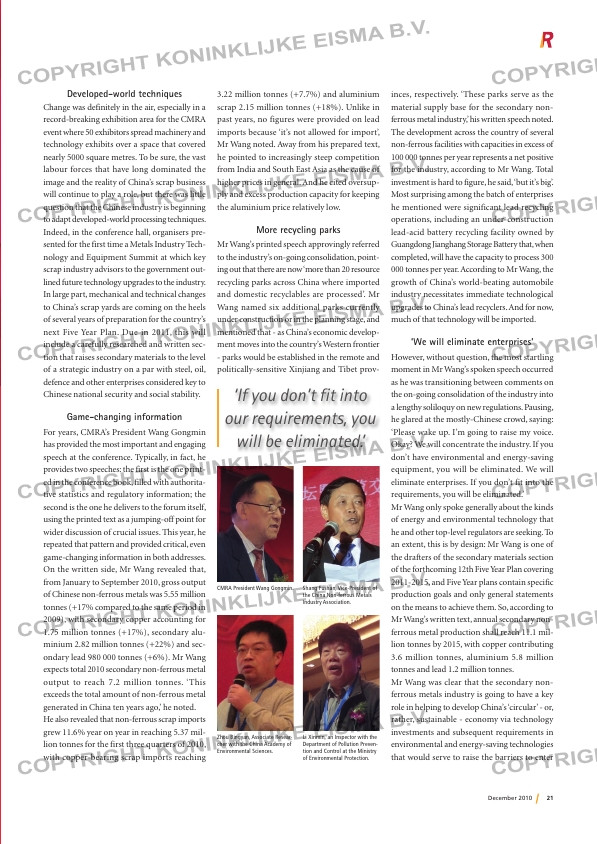Page 21 from: December 2010

21December 2010
Developed-world techniques
Change was definitely in the air, especially in a
record-breaking exhibition area for the CMRA
event where 50 exhibitors spread machinery and
technology exhibits over a space that covered
nearly 5000 square metres. To be sure, the vast
labour forces that have long dominated the
image and the reality of China’s scrap business
will continue to play a role, but there was little
question that the Chinese industry is beginning
to adapt developed-world processing techniques.
Indeed, in the conference hall, organisers pre-
sented for the first time a Metals Industry Tech-
nology and Equipment Summit at which key
scrap industry advisors to the government out-
lined future technology upgrades to the industry.
In large part, mechanical and technical changes
to China’s scrap yards are coming on the heels
of several years of preparation for the country’s
next Five Year Plan. Due in 2011, this will
include a carefully researched and written sec-
tion that raises secondary materials to the level
of a strategic industry on a par with steel, oil,
defence and other enterprises considered key to
Chinese national security and social stability.
Game-changing information
For years, CMRA’s President Wang Gongmin
has provided the most important and engaging
speech at the conference. Typically, in fact, he
provides two speeches: the first is the one print-
ed in the conference book, filled with authorita-
tive statistics and regulatory information; the
second is the one he delivers to the forum itself,
using the printed text as a jumping-off point for
wider discussion of crucial issues. This year, he
repeated that pattern and provided critical, even
game-changing information in both addresses.
On the written side, Mr Wang revealed that,
from January to September 2010, gross output
of Chinese non-ferrous metals was 5.55 million
tonnes (+17% compared to the same period in
2009), with secondary copper accounting for
1.75 million tonnes (+17%), secondary alu-
minium 2.82 million tonnes (+22%) and sec-
ondary lead 980 000 tonnes (+6%). Mr Wang
expects total 2010 secondary non-ferrous metal
output to reach 7.2 million tonnes. ‘This
exceeds the total amount of non-ferrous metal
generated in China ten years ago,’ he noted.
He also revealed that non-ferrous scrap imports
grew 11.6% year on year in reaching 5.37 mil-
lion tonnes for the first three quarters of 2010,
with copper-bearing scrap imports reaching
3.22 million tonnes (+7.7%) and aluminium
scrap 2.15 million tonnes (+18%). Unlike in
past years, no figures were provided on lead
imports because ‘it’s not allowed for import’,
Mr Wang noted. Away from his prepared text,
he pointed to increasingly steep competition
from India and South East Asia as the cause of
higher prices in general. And he cited oversup-
ply and excess production capacity for keeping
the aluminium price relatively low.
More recycling parks
Mr Wang’s printed speech approvingly referred
to the industry’s on-going consolidation, point-
ing out that there are now ‘more than 20 resource
recycling parks across China where imported
and domestic recyclables are processed’. Mr
Wang named six additional parks currently
under construction or in the planning stage, and
mentioned that – as China’s economic develop-
ment moves into the country’s Western frontier
– parks would be established in the remote and
politically-sensitive Xinjiang and Tibet prov-
inces, respectively. ‘These parks serve as the
material supply base for the secondary non-
ferrous metal industry,’ his written speech noted.
The development across the country of several
non-ferrous facilities with capacities in excess of
100 000 tonnes per year represents a net positive
for the industry, according to Mr Wang. Total
investment is hard to figure, he said, ‘but it’s big’.
Most surprising among the batch of enterprises
he mentioned were significant lead recycling
operations, including an under-construction
lead-acid battery recycling facility owned by
Guangdong Jianghang Storage Battery that, when
completed, will have the capacity to process 300
000 tonnes per year. According to Mr Wang, the
growth of China’s world-beating automobile
industry necessitates immediate technological
upgrades to China’s lead recyclers. And for now,
much of that technology will be imported.
‘We will eliminate enterprises’
However, without question, the most startling
moment in Mr Wang’s spoken speech occurred
as he was transitioning between comments on
the on-going consolidation of the industry into
a lengthy soliloquy on new regulations. Pausing,
he glared at the mostly-Chinese crowd, saying:
‘Please wake up. I’m going to raise my voice.
Okay? We will concentrate the industry. If you
don’t have environmental and energy-saving
equipment, you will be eliminated. We will
eliminate enterprises. If you don’t fit into the
requirements, you will be eliminated.’
Mr Wang only spoke generally about the kinds
of energy and environmental technology that
he and other top-level regulators are seeking. To
an extent, this is by design: Mr Wang is one of
the drafters of the secondary materials section
of the forthcoming 12th Five Year Plan covering
2011-2015, and Five Year plans contain specific
production goals and only general statements
on the means to achieve them. So, according to
Mr Wang’s written text, annual secondary non-
ferrous metal production shall reach 11.1 mil-
lion tonnes by 2015, with copper contributing
3.6 million tonnes, aluminium 5.8 million
tonnes and lead 1.2 million tonnes.
Mr Wang was clear that the secondary non-
ferrous metals industry is going to have a key
role in helping to develop China’s ‘circular’ – or,
rather, sustainable – economy via technology
investments and subsequent requirements in
environmental and energy-saving technologies
that would serve to raise the barriers to enter
CMRA President Wang Gongmin.
Zhou Bingyan, Associate Resear-
cher with the China Academy of
Environmental Sciences.
Shang Fushan, Vice-President of
the China Non-ferrous Metals
Industry Association.
Li Xinmin, an Inspector with the
Department of Pollution Preven-
tion and Control at the Ministry
of Environmental Protection.
‘If you don’t fit into
our requirements, you
will be eliminated.’
p20 in .indd 21 03-12-10 0 :38



